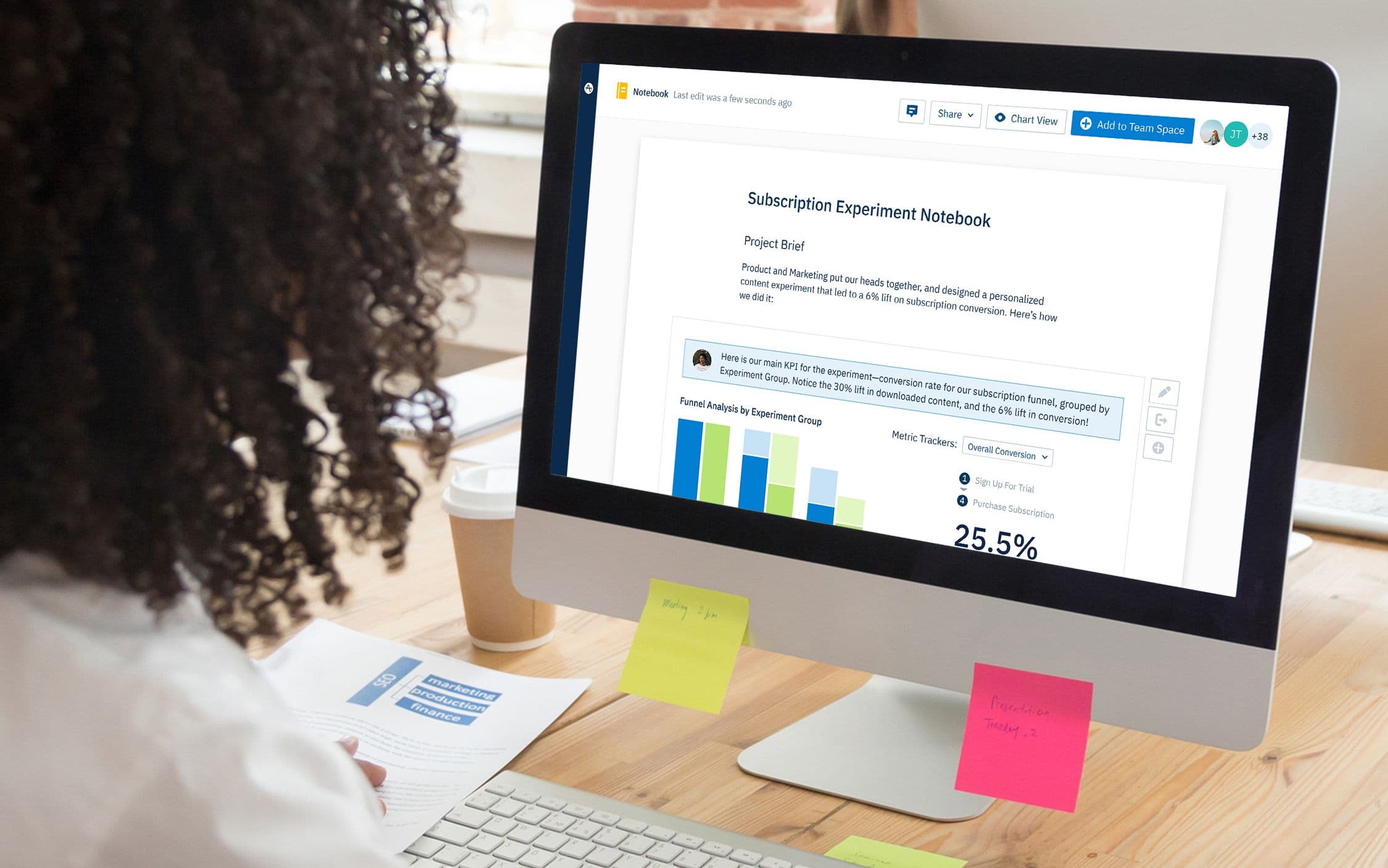Data Storytelling: The Skill Every Analytics Pro Should Master
Uncover the potential of data-driven stories to communicate business insights and drive better decisions.
Data storytelling is the missing link between the excellent data insights you obtain through product analytics and your ability to communicate its significance to stakeholders. Compelling data-driven storytelling guides decision-making processes.
Large datasets and complex graphs might be a data scientist’s bread and butter, but C-suite executives and other team members often need an accompanying narrative to help them understand the significance of data analytics.
The Bureau of Labor Statistics predicts that research analyst positions will see a 23% increase in demand between 2021 and 2031, a rapid growth rate compared to the 5% average for all occupations. As the field of data science grows in the business world, so does the art of data analytics storytelling.
Key takeaways
- Data analysts use data storytelling to communicate data-driven insights to encourage smarter business decisions.
- Data storytelling helps you command your audience’s attention, make better decisions, communicate more effectively, and better organize your data.
- Data storytelling consists of three core factors: data, visualization, and a good narrative.
- Data analysts should use powerful tools, like Amplitude’s Notebook, to improve their data storytelling.
- Studies show storytelling is an effective way to impart information and persuade people to take action.
What is data storytelling?
Data storytelling refers to how data analysts communicate key insights from data collected to stakeholders—particularly those in charge of making business decisions. Successful data storytellers tell compelling stories using good narratives and data visualization from collected data points.
When storytelling with data, you should:
- Present background information and justification for the data analysis.
- Explain risks and assumptions.
- Define relevant events, their properties, and the properties of the users analyzed.
- Outline your data collection and analysis methodology, and discuss the data sources and time frames.
- Include data visualization storytelling techniques using relevant charts, graphs, and infographics.
- Finalize your data story with a summary and suggested next steps.
An essential part of data storytelling is using robust tools that make sharing business analytics and insights easy. With Amplitude, you can use features like Notebooks to explain important insights to your teammates and stakeholders. Unlike dashboards, which are great for monitoring metrics, Notebooks gives you access to practical data storytelling functionality.
Notebooks are documents composed of a combination of:
- Markdown-enabled text blocks
- Relevant pictures and videos such as infographics, TED talks, and webinars
- Charts and chart takeaways
- Summary metrics
The rich information included in Notebooks can be used to:
- Report on performance.
- Explain analysis, insights, and patterns related to a product’s performance, engagement, conversion rates, retention, etc.
- Help teammates develop their own data storytelling skills so they can drive organizational change.
Four reasons why data storytelling is important
Good data storytelling plays a vital role in any company's development.
1. Command your audience’s attention
You need to hold your audience’s attention long enough to get your point across, and a strong narrative can help. In fact, research shows that a story’s narrative is vital to maintaining an audience’s attention over a time period.
2. Drive better decision-making
Psychologist and behavioral economist Daniel Kahneman once said, “No one ever made a decision because of a number. They need a story.” Rather than stale spreadsheets, data storytelling leverages immersive narratives and striking visuals, making it easier for decision-makers to understand the data’s significance.
3. Communicate important information efficiently
It can be challenging to present findings from the analysis of big data to audiences who don’t have an intimate understanding of, or high familiarity with, data analytics. Sharing this information through storytelling helps get your point across quickly without going into the nuts and bolts of data science.
4. Better organize your data
Data storytelling tools quickly collect and store data from disparate sources and present it in a way that easily surfaces insights when putting together business intelligence.
The link between data storytelling and persuasiveness
From cave paintings to Netflix documentaries, humankind has long used stories to pass down information to learn from our successes and failures. When we hear a story, multiple parts of our brain are engaged, including:
- Wernicke’s area, which is responsible for understanding language
- The amygdala, responsible for processing emotions
- Mirror neurons that help us empathize with others
- The hippocampus, which stores short-term memories and converts them into longer-term memories.
Storytelling is used across disciplines, most particularly in the education sector. Educational psychologists, like Jerome Bruner, have studied how storytelling makes learning more interesting, interactive, and effective.
“Rather than just retaining knowledge and facts, they go beyond them to use their imaginations to think about other outcomes, as they don't need the completion of a logical argument to understand a story. This helps them to think about facing the future.”
Jerome Bruner
Numerous studies have backed this up, including those outlined in Chip and Dan Heath’s groundbreaking book Made to Stick: Why Some Ideas Survive and Others Die. In the book, Chip Heath recalls asking his students at Stanford University to make one-minute presentations on the topic of non-violent crime. He then asked them to write down what they remembered from their classmates’ presentations:
“In the average one-minute speech, the typical student uses 2.5 statistics. Only one student in ten tells a story. Those are the speaking statistics. On the other hand, the “remembering” statistics are almost a mirror image: When students are asked to recall the speeches, 63% remember the stories. Only 5% remember any individual statistic.”
Storytelling requires you to be more persuasive in your arguments. Data Analyst Ian Whitehouse outlines three key steps to be more persuasive with data storytelling.
- Know your audience: Knowing your audience helps you determine the amount of context-setting required related to the date. Does your audience include internal or external stakeholders?
- Get to the point: Trim excess fat and get straight to the information your audience needs and wants to know.
- Use the right visuals: Visuals make storytelling more effective, but you should choose visuals that present your message clearly. If you’re talking about an increase or decrease in revenue, you should use a line graph instead of a pie chart.

This is an example of an Amplitude Notebook.
Data visualization basics
Data storytelling consists of three core components.
- Data: Having accurate data is the first step of telling a good story.
- Visuals: Visually present your findings and supporting data using charts, graphs, diagrams, and videos to make your story more appealing and memorable.
- Narrative: Build a narrative or storyline to communicate what you’ve learned from analyzing your data. This should also include the follow-up actions your audience needs to take at the end of the story.
Crafting a good data storytelling narrative follows the same steps of building a narrative for a movie or a book. A compelling narrative should have four elements, backed by relevant and powerful visualization.
- Characters: Who are the key players and stakeholders in your story? The characters could include your customers, social media audience, and teammates.
- Setting: Outline your story's context or starting point. For example, maybe your story begins at the end of Q3, and your sales are lower than projected at the beginning of the year. Your visualization should clearly show the starting point of your story. In this case, a graph comparing Q3 actuals versus start-of-year projections.
- Conflict: Every good story needs a villain or a source of conflict, and data storytelling is no different. For example, perhaps your low sales numbers are attributed to customer churn to a competitor’s new product. You could use charts comparing your dip in sales to your competitor’s product growth.
- Resolution: Everyone wants a happy ending; this is where your recommendations come in. Based on the data uncovered, present a plan to turn things around, win back your lost customers, and boost sales by the end of the year. Present visualizations of your predictions and compare them to your end-of-year sales if you continue on this current path.
If your story is about success, you might not have a conflict stage. For example, maybe you want to show how a new product update has contributed to customer retention and loyalty. The recommendations here would be more focused on how to maintain this momentum.
Who should master the skill of data storytelling?
Now that you understand the power and potential of data storytelling, you might be asking yourself, “Do I need to create a new position for a data storyteller on my team, or is this a skillset my data analysts can develop?”
After years of analyzing big data, your data analysts are likely able to identify and understand your data’s story using numbers alone. But this level of expertise can blind them to the fact that other stakeholders who are not entrenched in data don’t easily see the story.
Luckily a combination of upskilling and data storytelling tools, like Amplitude Notebooks, can help. As data storytelling becomes increasingly popular, it will likely become a critical capability listed in data analyst job descriptions.
However, great data storytelling isn’t only a skill set for data analysts. From marketers to financial controllers, anyone can communicate more effectively using the right tools to transform their data using a good story.
Check out this example Notebook in Amplitude’s demo data and then sign up for a free account to try it yourself today.

Darshil Gandhi
Director, Product Marketing, Amplitude
Darshil Gandhi is a Director of Product Marketing at Amplitude. He leads global technical and partner product marketing, collaborates with product and go-to-market teams on strategy, positioning, messaging, campaigns, and enablement. He was previously a solutions consulting team principal at Amplitude, and has helped dozens of Amplitude customers turn their data into actionable insights. Darshil graduated from Dartmouth College with a Masters in Engineering Management.
More from Darshil




